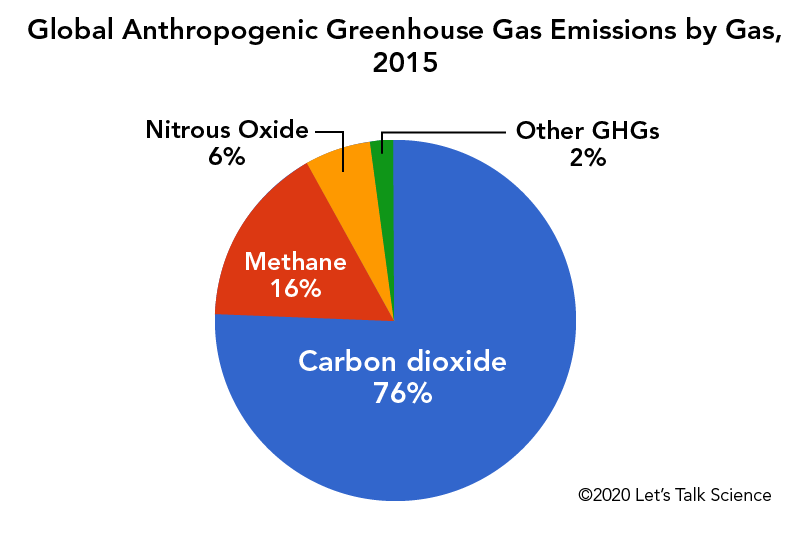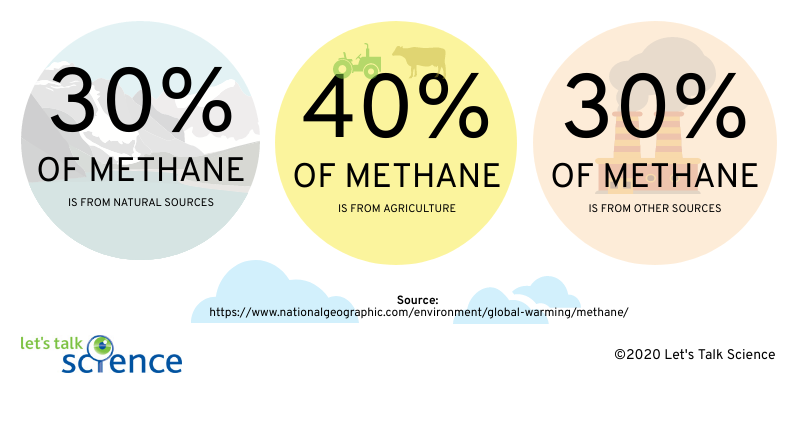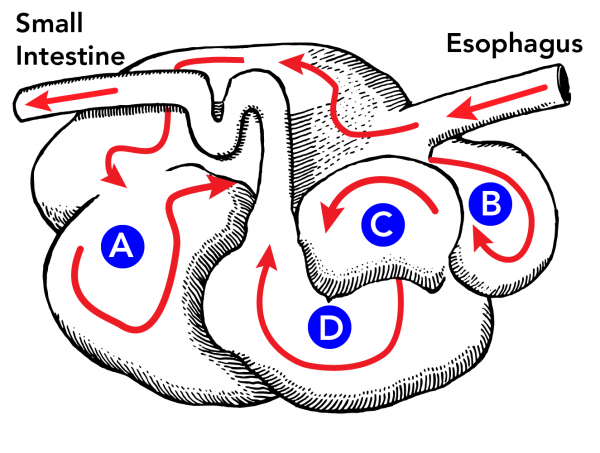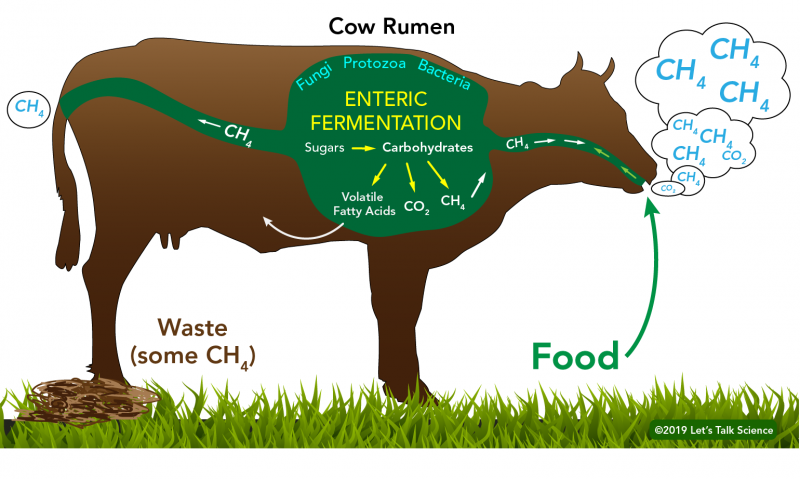Beef a Spercentage of Methane Emissions
Cows, Methane, and Climate Change
Cow (Firmafotografen, iStockphoto)
Cow (Firmafotografen, iStockphoto)
How does this align with my curriculum?
How do beef and dairy cows contribute to climate change? Livestock agriculture is a source of methane, a powerful greenhouse gas.
Over the last couple of centuries, Earth has become warmer. That's because ofgreenhouse gases released into the atmosphere.
One of the most commonly known greenhouse gases iscarbon dioxide (CO 2 ). Carbon dioxide is a colourless, odourless gas. It is released whenfossil fuels are burned. Burning fossil fuels releases carbon dioxide into the atmosphere. The carbon in the carbon dioxide was stored for millions of years under the ground in the form of hydrocarbons.
After carbon dioxide, the next most abundant greenhouse gas ismethane (CH4). Although carbon dioxide is much more abundant in the atmosphere than methane, methane traps roughly 30 times more heat than carbon dioxide. This makes methane an important gas to keep an eye on.
Graph - Text version
CO2 accounts for about 76 percent of total greenhouse gas emissions. Methane, primarily from agriculture, contributes 16 percent of greenhouse gas emissions and nitrous oxide, mostly from industry and agriculture, contributes 6 percent to global emissions. All figures here are expressed in CO2-equivalents.
Let's look more closely at where methane comes from. In particular, let's look at a source of methane that might surprise you: livestock.
What are the sources of methane emissions?
Methane comes from both natural sources andanthropogenic (human-related) sources. Natural sources include:
- Wetlands
- bodies of water
- Plant-eating animals (such as elephants, kangaroos, and termites!)
Human-related sources fall into four main categories:
- Natural gas-based
- Petroleum-based
- Agriculture-based
- Other sources
Agriculture-based sources include rice production,livestock, and manure management. Other sources include the burning of biomass, coal mining, and the treatment of waste in landfills and wastewater.
Graphic - Text version
30% of methane comes from natural sources, 40% from agricultural sources and 30% from other human-made sources.
How do livestock produce methane?
The beef and dairy cattle industry is one of the main contributors to global greenhouse gases. Methane makes up about half of the total greenhouse gases this sector emits. Cows generate methane in two main ways: through their digestion and through their waste.
Cows are part of a group of animals calledruminants. Ruminants have stomachs with four distinct chambers. Sheep, goats, and giraffes are also ruminants.
Image labels
In order, from beginning to end, food moves through the A: rumen; B: reticulum; C: omasum and D: abomasum.
The first chamber is called therumen. The rumen is home to a complex ecosystem ofmicroorganisms. These include bacteria, fungi, and protozoa. Some bacteria and protozoa break down the sugar and starch from plants. Others break down the cellulose that makes up plant cell walls.
The second chamber is thereticulum. This is where tough-to-digest plants, like grass, are stored. The plants are regurgitated and chewed again and again. This repeated chewing helps physically break the food down.
The third chamber is theomasum. It mechanically breaks the food down further.
The fourth chamber is theabomasum, or true stomach. Here, nutrients are extracted from the food. The food then proceeds through the digestive process.
Did you know?
The rumen contains about 200 species of microorganisms. But only about 10% of these play an important role in digestion.
An important process calledenteric fermentationtakes place in the rumen.That's when bacteria break down complex carbohydrates into simple sugars. The end products of enteric fermentation by bacteria includevolatile fatty acids (VFAs) as well as gases, such as carbon dioxide and methane. VFAs are absorbed through the walls of the rumen and transported to the liver where the animals use them for energy.
Did you know?
Cows release methane mainly through their belches (burps). The rest comes out as flatulence (farts).
Can we make cows produce less methane?
What cows eat has a big effect on how much methane they produce. Digesting certain types of food produces more methane than digesting other foods. For example, digesting hay and grass produces more methane than corn. Scientists are studying alternatives to cow feed that may produce less methane.
For example, scientists are trying adding seaweed to the cows' food. They hope that seaweed can inhibit a specificenzyme.That enzyme is involved in the production of methane while the cow digests its food. A 2018 experiment showed that adding seaweed to a cow's diet may reduce their methane production by as much as half! But researchers have found one problem with this solution: cows don't seem to like the salty taste of seaweed very much!
Other scientists are taking a genetic approach. A study published in 2019 found that the type and amount of methane-producing bacteria found in a cow's stomach is related to its genetic makeup. Knowing this, scientists can breed cows that have less of these bacteria in their stomachs. This will eventually create a type of genetically-modified cow that produces less methane!
Did you know?
We share our planet with 1.4 billion cows. Each of these animals produces 250 to 500 litres of methane every day!
What can you do to help fight climate change?
Many people like you and me are always looking for ways to keep greenhouse gas emissions down. For example, many of us choose to walk or bike instead of driving.
But as you have just learned, methane gas emissions from livestock are a huge problem. So driving less may not be the most important thing we can do to help mitigate climate change. Many experts now believe that eating less meat would actually have a bigger impact.
Connecting and Relating
- What would be your first response if a friend told you that they wanted to become a vegetarian or vegan?
- If you had to make the choice, which of your consumables would you choose to have decreased by half - fossil fuels or meats? Explain.
- Would you consider starting or joining a Meatless Monday campaign in your school? http://www.meatlessmonday.com/ Why/why not?
Connecting and Relating
- What would be your first response if a friend told you that they wanted to become a vegetarian or vegan?
- If you had to make the choice, which of your consumables would you choose to have decreased by half - fossil fuels or meats? Explain.
- Would you consider starting or joining a Meatless Monday campaign in your school? http://www.meatlessmonday.com/ Why/why not?
Relating Science and Technology to Society and the Environment
- Do you think governments should set methane (CH4) limits for agriculture? Explain.
- Should there be a carbon tax placed on beef and dairy products purchased by consumers? Why/why not?
- How should funds and resources be allocated to reduce agricultural greenhouse gas emissions?
- Describe the economic and social issues surrounding bovine agriculture.
Relating Science and Technology to Society and the Environment
- Do you think governments should set methane (CH4) limits for agriculture? Explain.
- Should there be a carbon tax placed on beef and dairy products purchased by consumers? Why/why not?
- How should funds and resources be allocated to reduce agricultural greenhouse gas emissions?
- Describe the economic and social issues surrounding bovine agriculture.
Exploring Concepts
- What are the main sources of methane globally?
- What is the difference between natural-source methane and anthropogenic methane? List examples of each.
- What is a ruminant? What is the function of the rumen?
- Describe the process of enteric fermentation. What role does methane play in this process?
- In terms of climate change, why are methane gas levels a concern?
- How much CH4 is produced per edible kilogram of cow agriculture compared to pig or chicken agriculture? (Note: This question will require additional research.)
Exploring Concepts
- What are the main sources of methane globally?
- What is the difference between natural-source methane and anthropogenic methane? List examples of each.
- What is a ruminant? What is the function of the rumen?
- Describe the process of enteric fermentation. What role does methane play in this process?
- In terms of climate change, why are methane gas levels a concern?
- How much CH4 is produced per edible kilogram of cow agriculture compared to pig or chicken agriculture? (Note: This question will require additional research.)
Nature of Science/Nature of Technology
- The scientific study of meat as a protein composed of amino acid building blocks has led to some success at growing cultured meat in a lab. How would you feel about switching your diet to lab-cultured meat? Explain.
- Should scientists continue to work on developing meat proteins in the lab as a way of reducing our dependence on farmed meat? Why/why not?
- Scientists are working on different approaches to collect the methane produced by cows so it can be burned as a cleaner fuel supply. One method involves using a tube permanently inserted into the cow's rumen to transfer the gas directly from the stomach into external collection chambers. Do you think this is an acceptable solution to reducing CH4 emissions into the atmosphere? Explain.
Nature of Science/Nature of Technology
- The scientific study of meat as a protein composed of amino acid building blocks has led to some success at growing cultured meat in a lab. How would you feel about switching your diet to lab-cultured meat? Explain.
- Should scientists continue to work on developing meat proteins in the lab as a way of reducing our dependence on farmed meat? Why/why not?
- Scientists are working on different approaches to collect the methane produced by cows so it can be burned as a cleaner fuel supply. One method involves using a tube permanently inserted into the cow's rumen to transfer the gas directly from the stomach into external collection chambers. Do you think this is an acceptable solution to reducing CH4 emissions into the atmosphere? Explain.
Media Literacy
- Should popular media play a greater role in promoting programs like Meatless Monday campaigns? Why/why not?
- Climate change campaigns generally suggest individuals take such actions as changing their light bulbs, taking shorter showers and carpooling to reduce personal CO2 emissions. Why do you suppose there has been so little media coverage about the climate change effects of agriculture, especially cow agriculture, in the media, despite it being a major greenhouse gas emitter?
Media Literacy
- Should popular media play a greater role in promoting programs like Meatless Monday campaigns? Why/why not?
- Climate change campaigns generally suggest individuals take such actions as changing their light bulbs, taking shorter showers and carpooling to reduce personal CO2 emissions. Why do you suppose there has been so little media coverage about the climate change effects of agriculture, especially cow agriculture, in the media, despite it being a major greenhouse gas emitter?
Teaching Suggestions
- This article can be used to support teaching and learning of Environmental Science, Climate Change and Chemistry related to beef and dairy cows, greenhouse gases, agriculture, climate change and sustainable living. Concepts introduced include greenhouse gases, fossil fuels, methane (CH4), anthropogenic, livestock, ruminants, rumen, microorganisms and enteric fermentation.
- To consolidate learning after reading this article, teachers could have students complete a Concept Definition Web learning strategy for the concept: enteric fermentation. Ready-to-use Concept Definition Web reproducibles are available in [Google doc] or [PDF] formats.
- To further explore the issue of reducing greenhouse gases, teachers could have students use a Pros & Cons Organizer learning strategy to consider the positive and negative aspects of reducing meat consumption in order to reduce methane emissions. Ready to use Pros & Cons Organizer reproducibles for this article are available in [Google doc] and [PDF] formats.
Teaching Suggestions
- This article can be used to support teaching and learning of Environmental Science, Climate Change and Chemistry related to beef and dairy cows, greenhouse gases, agriculture, climate change and sustainable living. Concepts introduced include greenhouse gases, fossil fuels, methane (CH4), anthropogenic, livestock, ruminants, rumen, microorganisms and enteric fermentation.
- To consolidate learning after reading this article, teachers could have students complete a Concept Definition Web learning strategy for the concept: enteric fermentation. Ready-to-use Concept Definition Web reproducibles are available in [Google doc] or [PDF] formats.
- To further explore the issue of reducing greenhouse gases, teachers could have students use a Pros & Cons Organizer learning strategy to consider the positive and negative aspects of reducing meat consumption in order to reduce methane emissions. Ready to use Pros & Cons Organizer reproducibles for this article are available in [Google doc] and [PDF] formats.
Learn more
Global Methane Budget (2012)
CBC News article by Haydn Watters discussing research that is underway at the University of Guelph that is studying methane released in cow burps and how to breed cows to prevent methane release.
The Global Methane Challenge
The Global Methane Initiative: take part in a global challenge to reduce your overall methane footprint!
References
Agriculture and Agri-Food Canada. (2016, November 8). Greenhouse gases. Government of Canada.
United States Environmental Protection Agency. (2019, April 11). Methane emissions.
Source: https://letstalkscience.ca/educational-resources/stem-in-context/cows-methane-and-climate-change




0 Response to "Beef a Spercentage of Methane Emissions"
Post a Comment